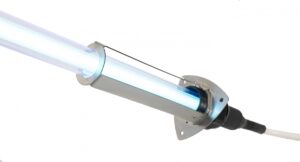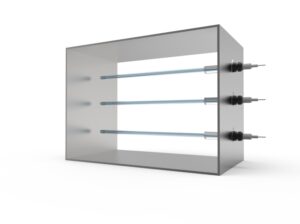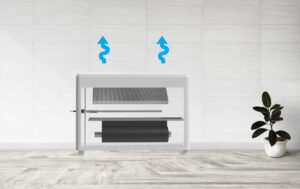UV-STYLO-X
UV-STYLO-X is simple, versatile, and adaptable to many different applications where hygiene is a concern owing to all-round radiation emitted by surfaces. UV-STYLO-X is applied inside the AC system, especially in narrow spaces, to improve Indoor Air Quality (IAQ), eliminating microbial loads and the spreading and distribution of hazardous and annoying pathogens. IAQ increases in hotels, offices, patient rooms, schools, etc., and comfort level improvement comes together with less operative costs: a cleaner Air Conditioning System is also more efficient from an economic point of view with better heating, cooling, and humidification performances. With UV-STYLO-X, you obtain deep and continuous disinfection and cleaning of your Air Conditioning System without using expensive and polluting chemicals. Using UVGI, maintenance operations and manual cleaning of inner surfaces are less necessary than usual. The UV-STYLO-X system provides better comfort for the people in your building and saves you money as well.
UV-STYLO-X
UV-STYLO-X is simple, versatile, and adaptable to many different applications where hygiene is a concern owing to all-round radiation emitted by surfaces. UV-STYLO-X is applied inside the AC system, especially in narrow spaces, to improve Indoor Air Quality (IAQ), eliminating microbial loads and the spreading and distribution of hazardous and annoying pathogens. IAQ increases in hotels, offices, patient rooms, schools, etc., and comfort level improvement comes together with less operative costs: a cleaner Air Conditioning System is also more efficient from an economic point of view with better heating, cooling, and humidification performances. With UV-STYLO-X, you obtain deep and continuous disinfection and cleaning of your Air Conditioning System without using expensive and polluting chemicals. Using UVGI, maintenance operations and manual cleaning of inner surfaces are less necessary than usual. The UV-STYLO-X system provides better comfort for the people in your building and saves you money as well.
Lorem ipsum dolor sit amet, consectetur adipiscing elit. Ut elit tellus, luctus nec ullamcorper mattis, pulvinar dapibus leo.
Sectors
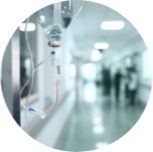
Health Care
Hospitals, Clinics, Labs
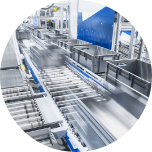
Food Processing
Food, Pharma Production

Hotel & Restaurants
Ho.Re.Ca

Shared Spaces
Schools, Offices, Retail
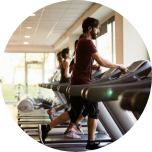
Wellness Centers
Gyms, Physicians, Campus
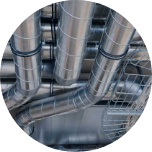
HVAC
Air Conditioning

Public Venues
Theaters, Arenas, Warehouses
Solutions

HVAC & AIR DISINFECTION
DISCOVER OTHER PRODUCTS
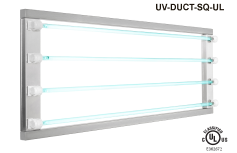
UV-DUCT-SQ / UV-DUCT-SQ-UL
Applied inside ducts, or inside AHU (Air Handling Unit) UV-DUCT-SQ creates an “UVGI section” that inhibits the proliferation of viruses, bacteria, moulds and spores settling
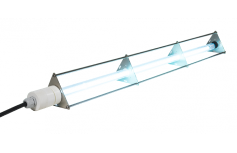
UV-STYLO-E
Installed inside the humidifier collection tanks (Cooling System) Air Handling Units (A.H.U.) UV-STYLO-E sanitizes the water recirculation system. UV-C treatment in water
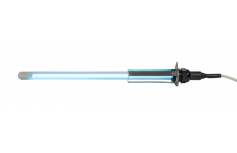
UV-STYLO-X
UV-STYLO-X system is very simple, versatile and adaptable to different types of applications, anywhere control is required as for hygiene level in a deep manner owing to an
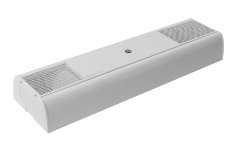
UV-FAN
UV-FAN allows deep air disinfection in any type of food environment. Traditional cleaning methods are, often, not sufficient to ensure high
FAQS
Ultraviolet rays are electromagnetic waves that are part of the electromagnetic spectrum. Electromagnetic waves are divided into three main wavelength bands, expressed in nanometers, nm: Ultraviolet rays (UV) 100-400 nm Visible rays (light) 400-700 nm Infrared rays (IR) 700-800,000 nm UV rays are in turn, identified in three bands:
- UV-A (315-400 nm) with tanning properties;
- UV-B (280-315 nm) con proprietà terapeutiche e di sintesi della vitamina “D”;
- UV-C (100-280 nm) with germicidal properties.
UV rays are eco-friendly. Bacteria, viruses, spores, fungi, molds, and mites are all sensitive to UV-C rays and can be eliminated by them. Microbes cannot acquire resistance to UV-C rays, which only occurs using chemical disinfectants and antibiotics. When using ordinary disinfectants, environmental pollution is inevitable.
They also carry severe risks from the direct inhalation of vapors or the ingestion of foods contaminated after coming into direct contact with chemical disinfectants. Where the use of chemical disinfectants is unavoidable (food/pharmaceutical/healthcare industries, etc.), using ultraviolet rays in the disinfection process can reduce the amount needed, which allows for significant cost savings and is better for the environment while maintaining – and most of the time, improving – disinfection quality.
UV-C ray devices can be installed in most environments and machinery.
They can be programmed to maintain the same level of disinfection day and night, ensuring ideal hygiene conditions without any fluctuation in quality. In contrast, chemical disinfectants are most effective at the time of use.
LIGHT PROGRESS UV-C-equipped devices offer low running costs and are maintenance-free, besides standard bulb replacement. These robust and highly durable systems provide exceptional value for money. For this reason, eliminating germs using UV-C as opposed to (or together with) other systems offers excellent results at a low cost.
UV-C rays (100-280 nm) have a robust germicidal effect and reach their maximum efficacy at the 265 nm wavelength. The germicidal effect of UV-C radiation covers bacteria, viruses, spores, fungi, molds, and mites; this is mainly due to the destructive impact of the UV-C rays on their DNA, which damages their reproductive system and prevents them from replicating.
These lamps have an emission of around 90% over the 253.7 nm wavelength. This frequency is invisible to the human eye and has solid germicidal power. The remaining 10% of the lamp’s emission is visible (typically appearing as a blueish light).
Yes, UV-C rays are found in nature as they are generated by the sun, but the ozone layer in the atmosphere acts as a shield that stops them from reaching the earth’s surface.
Legal limits for microbiological contamination of drinking water are very stringent under Legislative Decree 31/2011. Water can be treated chemically by chlorination or physically by UV-C rays and heat to eliminate microorganisms. Initially, ingested water may contain dangerous residual contaminants derived from chlorine, such as chloramines, which alter the taste and smell of water, or by-products harmful to human health and the environment, such as inorganic substances, which contribute to trihalomethane, which is highly carcinogenic. It may be possible to avoid the problems mentioned above by heating the water before use, but it is not practical and would require long cooling times to solve.
By irradiating microorganisms with a much higher dose than the minimum safety dose, a UV-C ray device installed on the pipe near the point of use of the water can safely eliminate all microorganisms. Systems and spare parts (lamps) are very inexpensive to buy and maintain. When chlorine and derivatives are present, UV-C rays reduce them to elementary particles that are harmless to humans.
When you turn on a UV-C lamp you get a strong reduction in the microbes present in the ambient air and on the surfaces reached by the UV rays. The device reduces Bacillus, Coli, Clostridium, Legionella, Vibrio, Salmonella, Listeria, Pseudomonas, Staphylococcus, Streptococcus Bacteria by 99% in a matter of minutes if placed three meters from it. This feature also allows you to intervene in areas otherwise unreachable by solid bodies such as objects and cleaning and disinfectant products. Although chemical disinfectants are mandatory, irradiating surfaces avoids shaded areas, does not generate resistant species and can be used day or night (in the absence of people), preventing rapid recontamination of surfaces and ensuring that they are always in optimal microbiological condition.
UV-C rays are used every day, primarily in:
Food and pharmaceutical industries disinfect the air and surfaces of production environments and disinfect product containers (packaging), to isolate “protected” areas for the production and packaging of products, such as clean rooms, from areas at risk of contamination. These actions significantly increase the safety and shelf life of the products we buy, with numerous benefits to our health given that they do not leave any residue and allow the elimination or reduction of chemical disinfectants, which on the contrary, may leave hazardous residue on the products.
Hospitals, to avoid the transmission, and therefore contagion of dangerous bacteria or viruses that may be found in their air or transmitted by contact between the sick and visitors.
Water treatment systems provide drinking water for humans and animals and for healthcare use to eliminate all microorganisms that might be found in water from wells, tanks, and aqueducts. This system is mandatory downstream of a carbon-activated filter, for example, in water dispensers, which are becoming increasingly popular in cities.
There are no limits to the possible applications of UV-C light; even in domestic environments, it is used to prevent mold formation on walls, eliminate mites from the bedroom, keep the indoor air healthy, and treat water.
UV-C light can also eliminate odors and grease deposits in industrial kitchens and restaurants, assisted by ozone emission. Light Progress has developed a specific system also for this type of application.
Bacteria, viruses, spores, fungi, molds, and mites are all sensitive to and eliminated by UV-C radiation.
Each bacterium, virus, yeast, mold, or mite requires a different UV-C dose to be deactivated or eliminated. There are widely recognized documents that report these levels. Light Progress has one of these documents and uses it regularly in designing and implementing its systems. To give an approximate idea regarding the application times of UV-C rays, these can range from fractions of a second to several seconds.
Viruses, bacteria, mold, animal waste, mites, and pollen are among the leading causes of dangerous infections and allergies. Each contaminant is dispersed differently: mites, spores, bacteria, and mold, for example, are continuously transported by air, while other bacteria and viruses are “grouped” into solid particles, such as spores or drops of moisture, and then inhaled by humans.
In air conditioning systems, when contaminants get inside the air treatment unit (ATU) and air distribution ducts, the design, which is dark and moist, becomes a breeding ground for them to grow and multiply, making the air we breathe unsafe.
The air also contains concentrations of dangerous chemical pollutants if inhaled in large quantities or continuously. Irradiating air in a central system or installing an air purifier complete with UV-C lamps and a TiOx titanium dioxide filter dramatically reduces the likelihood that these pollutants (whether microbiological or physicochemical) will result in health problems that often can only be diagnosed after many years.
The efficacy of disinfection systems can easily be ascertained through microbiological analyses or simple swab tests used to identify the presence of microorganisms on the tested surfaces. To verify the same microbial load on surfaces, in the air, and in water, before and after the treatment, it is necessary to carry out lab tests such as those for HACCP. For chemical disinfectants, producers need to provide tests declaring their disinfectant capacity; Light Progress has similarly carried out necessary tests in university labs and at private accredited bodies. Of course, for chemical disinfectants and UVGI technology to obtain the same laboratory results, the products must comply with the instructions for use.
UV-C rays cannot penetrate solid bodies, unlike ionizing radiation such as x-rays and gamma rays, which are highly dangerous to humans, even at low doses. To eliminate microorganisms using UV-C rays, they must be present on the surface of an object or transported by the air.
ARE THERE ANY MATERIALS THAT CAN BE PENETRATED BY UV-C RAYS?
Significantly few materials will not block the passage of the germicidal wavelength (253.7 nm, invisible), including quartz and certain plastics such as PE or tetrafluoro-derivatives, but only if these are just a few microbes thick.
Regular window glass, polycarbonate, and other transparent materials through which it is possible to see the bluish light of UV-C lights completely nullify their germicidal effect, acting as a screen.
WHAT EFFECT DO UV-C RAYS HAVE ON THE HUMAN BODY?
Continuous irradiation of the eyes and skin could cause erythema and conjunctivitis, which generally clear up in a few hours. In any case, it is sensible to avoid direct, close-up exposure to sources of UV-C rays, even for short periods. To prevent direct exposure, cover the area to be protected using any material that is not transparent to visible light (cotton or woolen clothing or overalls) or glass or transparent plastics (masks, helmets, glasses, etc.).
ARE THERE ANY WAYS TO PROTECT AGAINST FALLING FRAGMENTS FROM THE UV-C LAMP?
Yes. Light Progress offers two solutions in a unique plastic material: Uvlon Frame and Uvlon Pipe. Uvlon Frame is made from a film attached to the device and collects fragments from breakage. Uvlon Pipe is a casing thermally applied to the UV-C tube in the factory, which increases its mechanical strength (car windscreen effect) and collects and retains any broken fragments inside.
WHAT EFFECT DO UV-C RAYS HAVE ON PLASTIC SURFACES?
UV-C rays are similar to solar rays but do not transmit heat. However, like solar rays, they tend to have a yellowing effect on plastics exposed for extended periods (mainly white plastics).
Bacteria, Viruses, Spores, Fungi, Mold, and Mites are all sensitive to, and can therefore be eliminated with, UV-C light. Microbes cannot acquire resistance to UV-C light, unlike that which occurs using chemical disinfectants and antibiotics. UV rays are ecological. Polluting the environment is inevitable using normal disinfectants. Directly inhaling the vapors, or swallowing food products contaminated by any contact with said chemical disinfectants, can also give rise to a number of serious risks. In cases where chemical disinfectants cannot be eliminated (food, pharmaceutical, healthcare industries, etc.), using ultraviolet rays for disinfection allows a reduction in their use, with considerable economic savings and greater care for the environment, while maintaining and almost always improving the level of disinfection. UV-C light devices can be installed in environments and on machinery and be programmed to maintain the same level of disinfection day and night, guaranteeing ideal hygiene conditions, without highs and lows. On the contrary, chemical disinfectants are effective only during their actual use. Using LIGHT PROGRESS equipped luminaires, operating costs are negligible; it could be said that “LIGHT PROGRESS” UV-C systems do not require maintenance except for the normal replacement of the lamps. The cost/benefit ratio is considered excellent; the devices are both powerful and long-lasting. Hence the elimination of germs using UV-C technology is low-cost and highly effective compared to (or in combination with) other systems.
UV-C light genuinely works if properly applied and with the necessary precautions. The difference between a quality project, and an application that fails to bring the desired results, lies in the degree of knowledge about the subject, and level of experience acquired over time. Light Progress has been developing successful projects worldwide since 1987, and has built a client portfolio consisting of important companies in all fields requiring certified hygienic conditions to produce quality products and services.

